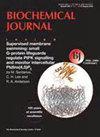来自寄生虫的细胞因子:通过分子模仿操纵宿主反应。
IF 4.3
3区 生物学
Q2 BIOCHEMISTRY & MOLECULAR BIOLOGY
引用次数: 0
摘要
蠕虫寄生虫已经进化出复杂的方法来操纵宿主的免疫反应,以确保在它们选择的生态位中长期生存,例如,通过分泌干扰宿主细胞因子网络的产物。对多回Heligmosomoides polygyrus分泌物的研究发现了一个转化生长因子-β (TGF-β)模拟物(TGMs)家族,其初级氨基酸序列与哺乳动物TGF-β没有相似性,但在限制性细胞类型中功能复制或拮抗TGF-β作用。在动物模型中,原型成员TGM1诱导Foxp3+ T调节细胞的体外分化,并减轻气道过敏和肠道炎症。TGM1是多回螺旋体表达的十个TGM蛋白家族中的一个。它是一个五结构域模块化蛋白,其中结构域1-2结合TGFBR1,结构域3结合TGFBR2;结构域4-5通过结合在免疫细胞上高度表达的共受体CD44来增强其效力。结构域4-5在其他TGMs中更为多样化,它们与成纤维细胞等细胞上的共受体结合。一种变体TGM6缺乏结构域1-2,因此不能转导信号,但通过结构域3与TGFBR2结合,并通过结构域4-5与成纤维细胞上表达的共受体结合,阻断成纤维细胞和上皮细胞中的TGF-β信号传导;T细胞不表达共受体,也不受TGM6的抑制。因此,不同的家族成员已经进化成对不同类型的细胞起激动剂或拮抗剂的作用。TGF-β受体通过分子模拟宿主细胞因子与宿主TGF-β受体的结合发挥作用,是来自寄生虫的高度进化的免疫调节剂,包括那些阻断白细胞介素(IL)-13和IL-33信号,调节巨噬细胞和树突状细胞反应和改变宿主细胞代谢的免疫调节剂。蠕虫逃避分子的出现和效力说明了在哺乳动物宿主中维持长期感染的一系列策略。本文章由计算机程序翻译,如有差异,请以英文原文为准。
Cytokines from parasites: manipulating host responses by molecular mimicry.
Helminth parasites have evolved sophisticated methods for manipulating the host immune response to ensure long-term survival in their chosen niche, for example, by secreting products that interfere with the host cytokine network. Studies on the secretions of Heligmosomoides polygyrus have identified a family of transforming growth factor-β (TGF-β) mimics (TGMs), which bear no primary amino acid sequence similarity to mammalian TGF-β, but functionally replicate or antagonise TGF-β effects in restricted cell types. The prototypic member, TGM1, induces in vitro differentiation of Foxp3+ T regulatory cells and attenuates airway allergic and intestinal inflammation in animal models. TGM1 is one of a family of ten TGM proteins expressed by H. polygyrus. It is a five-domain modular protein in which domains 1-2 bind TGFBR1, and domain 3 binds TGFBR2; domains 4-5 increase its potency by binding a co-receptor, CD44, highly expressed on immune cells. Domains 4-5 are more diverse in other TGMs, which bind co-receptors on cells such as fibroblasts. One variant, TGM6, lacks domains 1-2 and hence cannot transduce a signal but binds TGFBR2 through domain 3 and a co-receptor expressed on fibroblasts through domains 4-5 and blocks TGF-β signalling in fibroblasts and epithelial cells; T cells do not express the co-receptor and are not inhibited by TGM6. Hence, different family members have evolved to act as agonists or antagonists on various cell types. TGMs, which function by molecularly mimicking binding of the host cytokine to the host TGF-β receptors, are examples of highly evolved immunomodulators from parasites, including those that block interleukin (IL)-13 and IL-33 signalling, modulate macrophage and dendritic cell responses and modify host cell metabolism. The emerging panoply and potency of helminth evasion molecules illustrates the range of strategies in play to maintain long-term infections in the mammalian host.
求助全文
通过发布文献求助,成功后即可免费获取论文全文。
去求助
来源期刊

Biochemical Journal
生物-生化与分子生物学
CiteScore
8.00
自引率
0.00%
发文量
255
审稿时长
1 months
期刊介绍:
Exploring the molecular mechanisms that underpin key biological processes, the Biochemical Journal is a leading bioscience journal publishing high-impact scientific research papers and reviews on the latest advances and new mechanistic concepts in the fields of biochemistry, cellular biosciences and molecular biology.
The Journal and its Editorial Board are committed to publishing work that provides a significant advance to current understanding or mechanistic insights; studies that go beyond observational work using in vitro and/or in vivo approaches are welcomed.
Painless publishing:
All papers undergo a rigorous peer review process; however, the Editorial Board is committed to ensuring that, if revisions are recommended, extra experiments not necessary to the paper will not be asked for.
Areas covered in the journal include:
Cell biology
Chemical biology
Energy processes
Gene expression and regulation
Mechanisms of disease
Metabolism
Molecular structure and function
Plant biology
Signalling
 求助内容:
求助内容: 应助结果提醒方式:
应助结果提醒方式:


